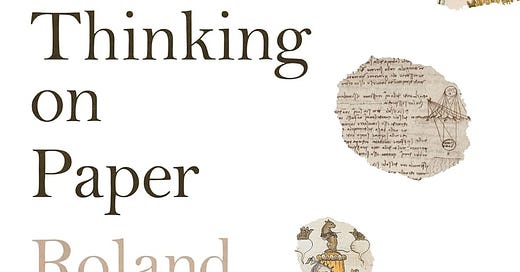The Notebook: A History of Thinking on Paper by Roland Allen
A Non-Fiction Review by Michael Greenstein
During August, 1916 T.S. Eliot wrote about reviewing: “Composing on the typewriter, I feel that I am sloughing off all my long sentences which I used to dote upon. Short, staccato, like modern French prose. The typewriter makes for brevity, but I am not sure that it encourages subtlety.” Henry James wrote longhand sentences, whereas Hemingway the reporter composed shorter, staccato prose. In The Notebook: A History of Thinking on Paper, Roland Allen chronicles different forms of writing with the clarity and subtlety of the finest pen on paper.
Allen’s “Introduction” focuses on Maria Sebregondi, an Italian on a boat in the Mediterranean who comes up with a marketing brainwave, thanks to her serendipitous reading of Bruce Chatwin’s The Songlines. Two passages stuck out in her mind: the first concerns Chatwin’s mention of notebooks that he purchased in Paris, but are no longer available; the second refers to the true Moleskine made in Tours, again no longer available. She then proceeds to revive the classic Moleskine notebook. The brand’s message: “The Moleskine is an exact reproduction of the legendary notebook of Chatwin, Hemingway, Matisse …. an accumulator of emotions that releases its charge over time.”
Allen contrasts the notebook with such devices as laptop, iPhone, and iPad, which return to Eliot’s distinction noted above. “Something about the act of writing by hand, and the production of a physical object, makes the older technology more effective than the new.” He begins his history in a castle in the Turkish city of Bodrum where a display case in the Museum of Underwater Archaeology shows off items recovered from the bottom of the Mediterranean. In the case sits a small wood-and-ivory, hinged writing tablet. Allen’s chronicle cruises around the Mediterranean with stops in Italy, Greece, and Egypt. The invention of accounting in Provence and Florence in 1299 goes hand in hand with the development of ledgers and notebooks.
As we voyage across centuries and the Mediterranean, we learn various languages and terminologies pertaining to the notebook. Ricordi, ricordanzi, and zibaldoni come to life. Chapters tantalize: “Pepper in Alexandria,” “Wicked Wives and Mouths Stopped with Wool” (where the notebook comes alive in sixteenth-century England). The origins of singing in harmony appear: gymel, from the Latin and Italian for twins, points to the doubling of voices. Allen moves fluidly between musical note and notebook: “This formal study of musical theory shows us how classical music evolved out of liturgical chanting and towards the harmonic sophistication that Bach, Mozart and Beethoven would master – and, for that matter, Nina Simone and John Coltrane.”
“Allen’s book is wonderfully illustrated, and subsections separated by three diagonal pens add to its charm.”
He covers commonplace books from Erasmus to the present, fish books of herring in the Netherlands, Dutch friendship books, table books, naturalists’ notebooks, diaries and journals, police notebooks, recipe books, climate logs, and patients’ diaries. Allen’s book is wonderfully illustrated, and subsections separated by three diagonal pens add to its charm.
The book concludes by coming full circle to Maria Sebregondi who binds the pages together: “And we should all be grateful to their customers, who realized the notebook’s affordances, and who understood implicitly that by taking the time and effort to externalize their thoughts, to draw a line, to work out a sum or manipulate an equation, they were expanding their minds.” Likewise, we should all be grateful to Allen for his noteworthy book.
About the Author
Roland Allen lives in Brighton. He studied at Manchester University and works in book (and notebook) publishing. He has written books on bicycles and bread, has kept a diary for decades, and enjoys stationery a little too much.
About the Reviewer
Michael Greenstein is a retired professor of English (Université de Sherbrooke). He is the author of Third Solitudes: Tradition and Discontinuity in Jewish-Canadian Literature and has published widely on Victorian, Canadian, and American-Jewish literature.
Book Details
Publisher : Biblioasis (Sept. 3 2024)
Language : English
Paperback : 416 pages
ISBN-10 : 1771966289
ISBN-13 : 978-1771966283






Thank you so much for this review! Really glad that you liked the book.
A book about notebooks seems right up my alley! Thanks for the review; I’m not sure I’d have seen this otherwise!